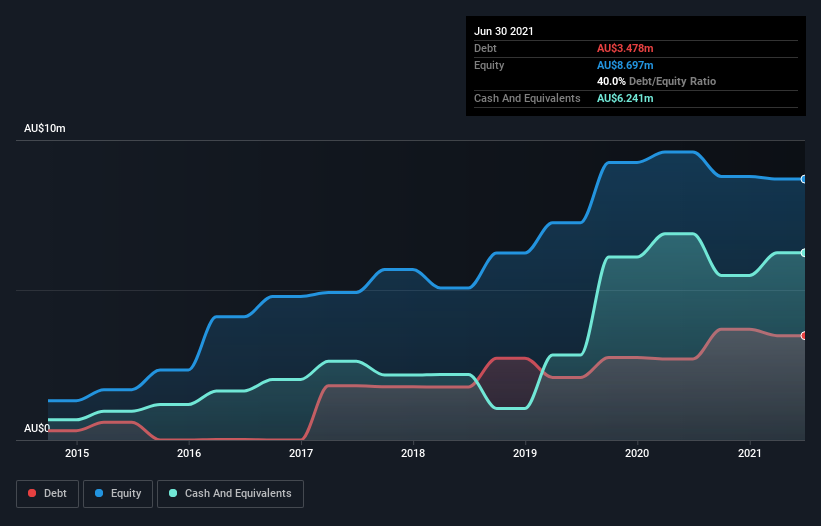Is Rectifier Technologies (ASX:RFT) A Risky Investment?
Legendary fund manager Li Lu (who Charlie Munger backed) once said, 'The biggest investment risk is not the volatility of prices, but whether you will suffer a permanent loss of capital.' When we think about how risky a company is, we always like to look at its use of debt, since debt overload can lead to ruin. We can see that Rectifier Technologies Limited (ASX:RFT) does use debt in its business. But is this debt a concern to shareholders?
When Is Debt A Problem?
Generally speaking, debt only becomes a real problem when a company can't easily pay it off, either by raising capital or with its own cash flow. Ultimately, if the company can't fulfill its legal obligations to repay debt, shareholders could walk away with nothing. However, a more usual (but still expensive) situation is where a company must dilute shareholders at a cheap share price simply to get debt under control. Of course, the upside of debt is that it often represents cheap capital, especially when it replaces dilution in a company with the ability to reinvest at high rates of return. When we examine debt levels, we first consider both cash and debt levels, together.
See our latest analysis for Rectifier Technologies
What Is Rectifier Technologies's Debt?
You can click the graphic below for the historical numbers, but it shows that as of June 2021 Rectifier Technologies had AU$3.48m of debt, an increase on AU$2.70m, over one year. But on the other hand it also has AU$6.24m in cash, leading to a AU$2.76m net cash position.
How Healthy Is Rectifier Technologies' Balance Sheet?
According to the last reported balance sheet, Rectifier Technologies had liabilities of AU$4.78m due within 12 months, and liabilities of AU$3.36m due beyond 12 months. Offsetting this, it had AU$6.24m in cash and AU$2.80m in receivables that were due within 12 months. So it actually has AU$895.0k more liquid assets than total liabilities.
This short term liquidity is a sign that Rectifier Technologies could probably pay off its debt with ease, as its balance sheet is far from stretched. Succinctly put, Rectifier Technologies boasts net cash, so it's fair to say it does not have a heavy debt load!
In fact Rectifier Technologies's saving grace is its low debt levels, because its EBIT has tanked 64% in the last twelve months. When it comes to paying off debt, falling earnings are no more useful than sugary sodas are for your health. The balance sheet is clearly the area to focus on when you are analysing debt. But you can't view debt in total isolation; since Rectifier Technologies will need earnings to service that debt. So when considering debt, it's definitely worth looking at the earnings trend. Click here for an interactive snapshot.
Finally, a company can only pay off debt with cold hard cash, not accounting profits. Rectifier Technologies may have net cash on the balance sheet, but it is still interesting to look at how well the business converts its earnings before interest and tax (EBIT) to free cash flow, because that will influence both its need for, and its capacity to manage debt. Over the most recent three years, Rectifier Technologies recorded free cash flow worth 69% of its EBIT, which is around normal, given free cash flow excludes interest and tax. This free cash flow puts the company in a good position to pay down debt, when appropriate.
Summing up
While it is always sensible to investigate a company's debt, in this case Rectifier Technologies has AU$2.76m in net cash and a decent-looking balance sheet. The cherry on top was that in converted 69% of that EBIT to free cash flow, bringing in AU$1.1m. So we are not troubled with Rectifier Technologies's debt use. There's no doubt that we learn most about debt from the balance sheet. However, not all investment risk resides within the balance sheet - far from it. To that end, you should be aware of the 2 warning signs we've spotted with Rectifier Technologies .
Of course, if you're the type of investor who prefers buying stocks without the burden of debt, then don't hesitate to discover our exclusive list of net cash growth stocks, today.
This article by Simply Wall St is general in nature. We provide commentary based on historical data and analyst forecasts only using an unbiased methodology and our articles are not intended to be financial advice. It does not constitute a recommendation to buy or sell any stock, and does not take account of your objectives, or your financial situation. We aim to bring you long-term focused analysis driven by fundamental data. Note that our analysis may not factor in the latest price-sensitive company announcements or qualitative material. Simply Wall St has no position in any stocks mentioned.
Have feedback on this article? Concerned about the content? Get in touch with us directly. Alternatively, email editorial-team (at) simplywallst.com.

 Yahoo Finance
Yahoo Finance 
